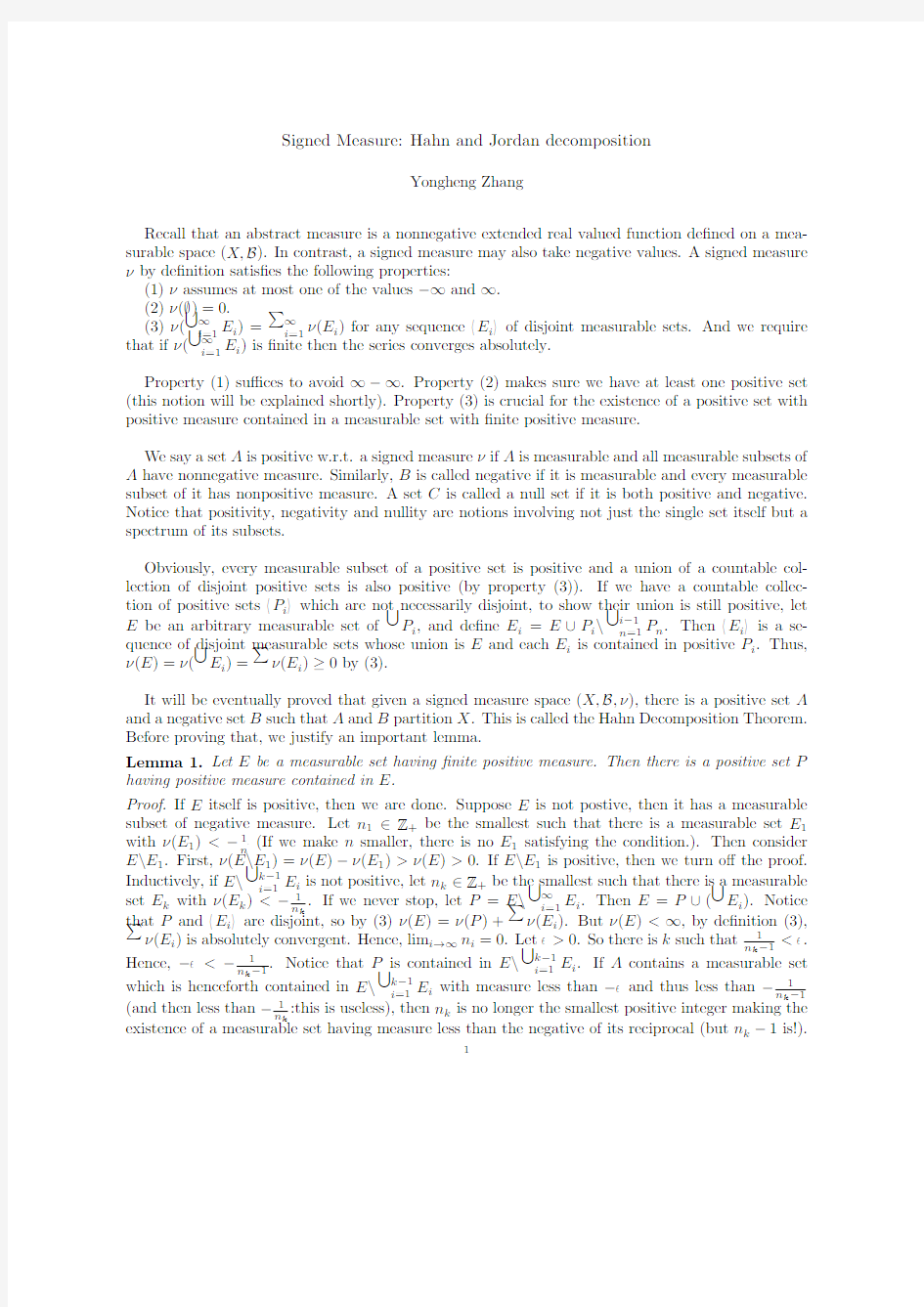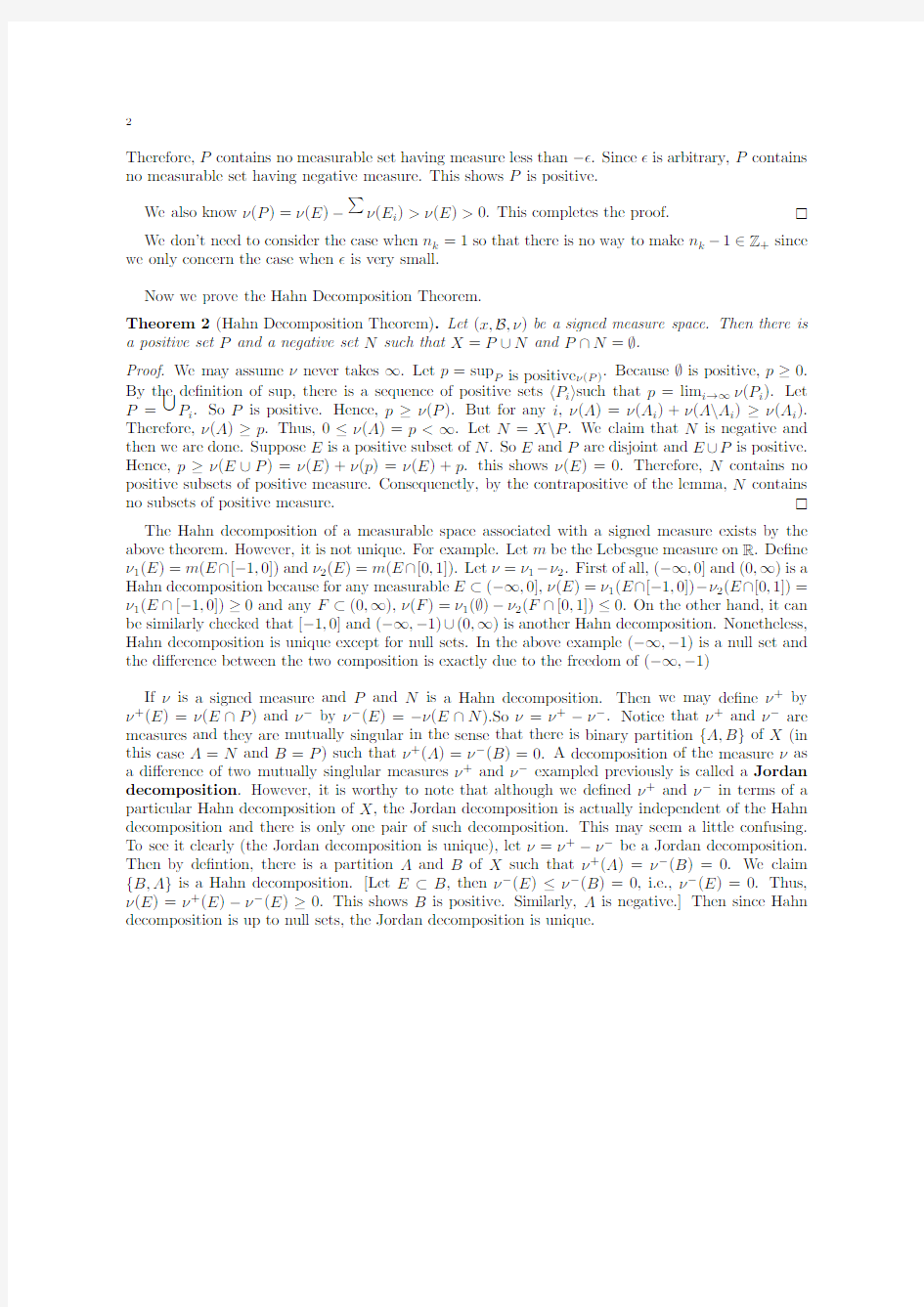Hanh decompostion


Signed Measure:Hahn and Jordan decomposition
Yongheng Zhang
Recall that an abstract measure is a nonnegative extended real valued function de?ned on a mea-surable space (X,B ).In contrast,a signed measure may also take negative values.A signed measure νby de?nition satis?es the following properties:
(1)νassumes at most one of the values ?∞and ∞.
(2)ν(?)=0.(3)ν( ∞i =1E i )= ∞i =1ν(E i )for any sequence E i of disjoint measurable sets.And we require that if ν( ∞i =1E i )is ?nite then the series converges absolutely.
Property (1)su?ces to avoid ∞?∞.Property (2)makes sure we have at least one positive set (this notion will be explained shortly).Property (3)is crucial for the existence of a positive set with positive measure contained in a measurable set with ?nite positive measure.
We say a set A is positive w.r.t.a signed measure νif A is measurable and all measurable subsets of A have nonnegative measure.Similarly,B is called negative if it is measurable and every measurable subset of it has nonpositive measure.A set C is called a null set if it is both positive and negative.Notice that positivity,negativity and nullity are notions involving not just the single set itself but a spectrum of its subsets.
Obviously,every measurable subset of a positive set is positive and a union of a countable col-lection of disjoint positive sets is also positive (by property (3)).If we have a countable collec-tion of positive sets P i which are not necessarily disjoint,to show their union is still positive,let E be an arbitrary measurable set of P i ,and de?ne E i =E ∪P i \ i ?1n =1P n .Then E i is a se-quence of disjoint measurable sets whose union is E and each E i is contained in positive P i .Thus,ν(E )=ν( E i )= ν(E i )≥0by (3).
It will be eventually proved that given a signed measure space (X,B ,ν),there is a positive set A and a negative set B such that A and B partition X .This is called the Hahn Decomposition Theorem.Before proving that,we justify an important lemma.
Lemma 1.Let E be a measurable set having ?nite positive measure.Then there is a positive set P having positive measure contained in E .
Proof.If E itself is positive,then we are done.Suppose E is not postive,then it has a measurable subset of negative measure.Let n 1∈Z +be the smallest such that there is a measurable set E 1with ν(E 1)ν(E )>0.If E \E 1is positive,then we turn o?the proof.Inductively,if E \ k ?1i =1E i is not positive,let n k ∈Z +be the smallest such that there is a measurable set E k with ν(E k )0.So there is k such that 1n k ?1< .Hence,?
1
2
Therefore,P contains no measurable set having measure less than ? .Since is arbitrary,P contains no measurable set having negative measure.This shows P is positive.
We also know ν(P )=ν(E )? ν(E i )>ν(E )>0.This completes the proof. We don’t need to consider the case when n k =1so that there is no way to make n k ?1∈Z +since we only concern the case when is very small.
Now we prove the Hahn Decomposition Theorem.
Theorem 2(Hahn Decomposition Theorem).Let (x,B ,ν)be a signed measure space.Then there is a positive set P and a negative set N such that X =P ∪N and P ∩N =?.
Proof.We may assume νnever takes ∞.Let p =sup P is positive ν(P ).Because ?is positive,p ≥0.By the de?nition of sup,there is a sequence of positive sets P i such that p =lim i →∞ν(P i ).Let P = P i .So P is positive.Hence,p ≥ν(P ).But for any i ,ν(A )=ν(A i )+ν(A \A i )≥ν(A i ).Therefore,ν(A )≥p .Thus,0≤ν(A )=p <∞.Let N =X \P .We claim that N is negative and then we are done.Suppose E is a positive subset of N .So E and P are disjoint and E ∪P is positive.Hence,p ≥ν(E ∪P )=ν(E )+ν(p )=ν(E )+p .this shows ν(E )=0.Therefore,N contains no positive subsets of positive measure.Consequenetly,by the contrapositive of the lemma,N contains no subsets of positive measure.
The Hahn decomposition of a measurable space associated with a signed measure exists by the above theorem.However,it is not unique.For example.Let m be the Lebesgue measure on R .De?ne ν1(E )=m (E ∩[?1,0])and ν2(E )=m (E ∩[0,1]).Let ν=ν1?ν2.First of all,(?∞,0]and (0,∞)is a Hahn decomposition because for any measurable E ?(?∞,0],ν(E )=ν1(E ∩[?1,0])?ν2(E ∩[0,1])=ν1(E ∩[?1,0])≥0and any F ?(0,∞),ν(F )=ν1(?)?ν2(F ∩[0,1])≤0.On the other hand,it can be similarly checked that [?1,0]and (?∞,?1)∪(0,∞)is another Hahn decomposition.Nonetheless,Hahn decomposition is unique except for null sets.In the above example (?∞,?1)is a null set and the di?erence between the two composition is exactly due to the freedom of (?∞,?1)
If νis a signed measure and P and N is a Hahn decomposition.Then we may de?ne ν+by ν+(E )=ν(E ∩P )and ν?by ν?(E )=?ν(E ∩N ).So ν=ν+?ν?.Notice that ν+and ν?are measures and they are mutually singular in the sense that there is binary partition {A,B }of X (in this case A =N and B =P )such that ν+(A )=ν?(B )=0.A decomposition of the measure νas a di?erence of two mutually singlular measures ν+and ν?exampled previously is called a Jordan decomposition .However,it is worthy to note that although we de?ned ν+and ν?in terms of a particular Hahn decomposition of X ,the Jordan decomposition is actually independent of the Hahn decomposition and there is only one pair of such decomposition.This may seem a little confusing.To see it clearly (the Jordan decomposition is unique),let ν=ν+?ν?be a Jordan decomposition.Then by de?ntion,there is a partition A and B of X such that ν+(A )=ν?(B )=0.We claim {B,A }is a Hahn decomposition.[Let E ?B ,then ν?(E )≤ν?(B )=0,i.e.,ν?(E )=0.Thus,ν(E )=ν+(E )?ν?(E )≥0.This shows B is positive.Similarly,A is negative.]Then since Hahn decomposition is up to null sets,the Jordan decomposition is unique.
